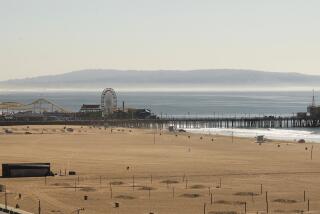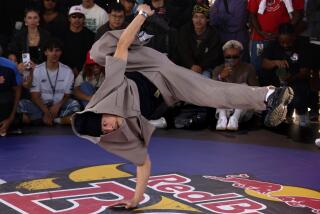Santa Monica Shows Off a Restored Muscle Beach
With their biceps-bulging handstands and eye-popping acrobatic flips, generations of buffed and bronzed athletes ruled the sands at Santa Monica’s Muscle Beach from 1934 to 1958.
Then one night without warning the city flexed its muscle and ripped out the gymnasts’ platforms, rings and balancing bars.
Never mind that the beach was the place that America’s emerging fitness boom was born. The huge crowds of onlookers were a nuisance, city officials decided--decreeing that the name “Muscle Beach” never again be used to identify the tiny spit of beachfront south of the Santa Monica Pier at the foot of Arcadia Terrace.
The gymnasts drifted away, and weightlifters whose presence had particularly irked some people in Santa Monica picked up their barbells and moved a few miles south to eventually establish Venice Beach’s Pit area.
But today Santa Monica leaders will unveil a new Muscle Beach at the site of the original one.
It is part of a $10-million beachfront refurbishing effort, financed by county park bonds, that will be celebrated with events starting at 12:30 this afternoon south of the pier. Some 200 gymnasts, including Olympic stars Nadia Comaneci and Tim Daggett, will perform from 2 to 4 p.m.
Not only is the city putting gymnastics equipment back on the sand, it is restoring the Muscle Beach name and inviting back the gymnasts and physical fitness buffs it chased away.
About $200,000 worth of heavy-duty gear is on order. Borrowed apparatus will be used for today’s events. For children, pint-size climbing ropes and horizontal bars have been already been installed.
“We’re actually replacing, inch by inch, bar by bar, the original Muscle Beach equipment,” said Barbara Stinchfield, the city’s director of Community and Cultural Services.
But there are no immediate plans to restore permanent weightlifting facilities. Officials figure most bodybuilders will stay in Venice, where special amenities have been built for them.
Most surviving Muscle Beach pioneers are in their 80s now. They say it’s about time Santa Monica mustered the strength to correct its 1958 mistake.
“I’m optimistic this is going to put the city on the map again,” said Paula Boelsems, whose Muscle Beach roots extend to 1939, when she began doing flips and working on the rings as a youngster.
Actually, say the old-timers, road maps in the 1940s often showed the name “Muscle Beach” in bigger print than the name “Santa Monica.”
Some of the muscular characters who exercised and performed on a 24-by-80-foot platform near the beach’s rings and parallel bars seemed bigger than life, too.
Body builders Jack LaLanne and the late Vic Tanny and actor Steve “Hercules” Reeves worked out there. So did acrobats such as George Eiferman, voted Mr. America in 1948 and Mr. Universe in 1962, and Glenn Sundby--who later would gain fame by walking down the 898 steps of the Washington Monument on his hands.
“I don’t think you can re-create what we had back in those days,” said Les Stockton, who in 1939 helped Sundby do his first handstand. “We were all young and innocent back then. We didn’t know we were creating the physical fitness movement. We were just having fun.”
Stockton, 83, of Santa Monica, married another Muscle Beach regular, Abbye Eville. She then was a 19-year-old telephone operator who had turned to exercise after earning the childhood nickname “Pudgy.”
Pudgy Stockton, 82, said new generations of gymnasts and fitness advocates could return Muscle Beach to its glory days.
“It will depend on the people who come here. It won’t be the equipment they put in. But I think the word will get out and people will come.”
According to old-timers, it didn’t take long for the first Muscle Beach to catch on after it got its start as a Depression-era Works Progress Administration project.
After the 1933 Long Beach earthquake damaged high school gymnasiums in the area, athletes turned to the beach as a place for gymnastics practice.
Although weightlifters frequented the beach, veterans say Muscle Beach got its name mainly from the physiques of the men and women who soared from the rings and formed human pyramids.
Muscle Beach pioneer Harold Zinkin, a weightlifter who was named the first Mr. California in 1941 and went on to invent the Universal Gym Machine, has traced the history of the beach in a new book, “Remembering Muscle Beach.”
Although personal exercise regimes were something of an oddity in the 1930s, “just about everyone liked watching the gymnasts, wrestlers and weightlifters who performed at Muscle Beach,” said Zinkin, 76, of Fresno.
“By observing the athletes’ exercise routines and their impromptu shows, people picked up the not-so-subtle message of fitness. Besides, it was great free entertainment, something Americans needed in those days.”
The beach’s heyday continued into the 1950s, even though some of the original Muscle Beach athletes began leaving to open their own professional gyms and fitness centers.
The growing popularity of weekend exhibitions by the athletes--some Sunday afternoon crowds totaled 10,000--soon became a problem, however.
Beach veteran Deforrest Most, 82, of Venice, said he suspects businessmen on the Santa Monica Pier pressured the city to shut down Muscle Beach. The arrest of five weightlifters in December 1958 on suspicion of statutory rape at a party in an apartment near the beach gave officials a reason.
The weightlifters were never charged. The city agreed to return some of the gymnastics equipment later, but Muscle Beach was dead.
The new Muscle Beach has been developed with the help of some of the surviving beach pioneers, said Rick Espe, a designer involved with the project.
“There’s been a lot of give and take, but we hope we’ve captured the past,” said Espe, of San Diego. “But we also want to capture the next generation.”
More to Read
Sign up for Essential California
The most important California stories and recommendations in your inbox every morning.
You may occasionally receive promotional content from the Los Angeles Times.











